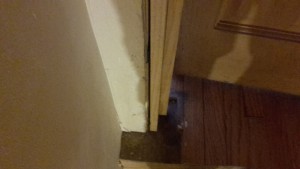The rough opening for a door is directly relational to its size. For prehung single doors, the formula is simple, just add 2″ for the width and 2 1/2″ for the height.
Rough Openings for Doors
The reason why the rough opening is 2″ wider than the door is because of the door jamb on each side and the room needed to set the door. Take for example a 3/0 door; the door itself measures 36″, the jambs are 3/4″ * 2 = 1 1/2″. This adds up to 37 1/2″ for the size of the unit. The other 1/2″ is to allow for room when positioning the door in the rough opening. The opening itself may not be exactly plumb so that extra 1/2″ gives you just a little bit to play with.
For anything besides a pre-hung single door, the rough opening can be more complicated. Just take a brief look at double doors. There is two jambs and two doors this time. On a double 3/0 door both of the doors add up to be 72″; the problem is that depending on the manufacturer they jambs could be thicker than 3/4″. The rough opening would not be wide enough by adding things up for a door with one inch thick jambs and only allowing 3/4″ for them. Always consult with the supplier for the rough opening for any door besides a pre-hung single unit.
If for whatever reason, the rough opening must be framed so that progress can continue, and there is no way to find out the exact size of the unit at the present time, just remember it is much easier to close an opening in than it is to open it up. When a rough opening is too small, and there is no other option except to make it larger, then there is no choice but to remove the header and jack-studs assemblies and start over. The jack-stud built-ups can be re-used, but the header will be too short. Even when trusting the dimensions furnished by the supplier, there is always the possibility for human error; the only fool-proof way to determine the size of the rough opening for anything beside a pre-hung single door is to actually measure the unit itself and add 1/2″ to it.

